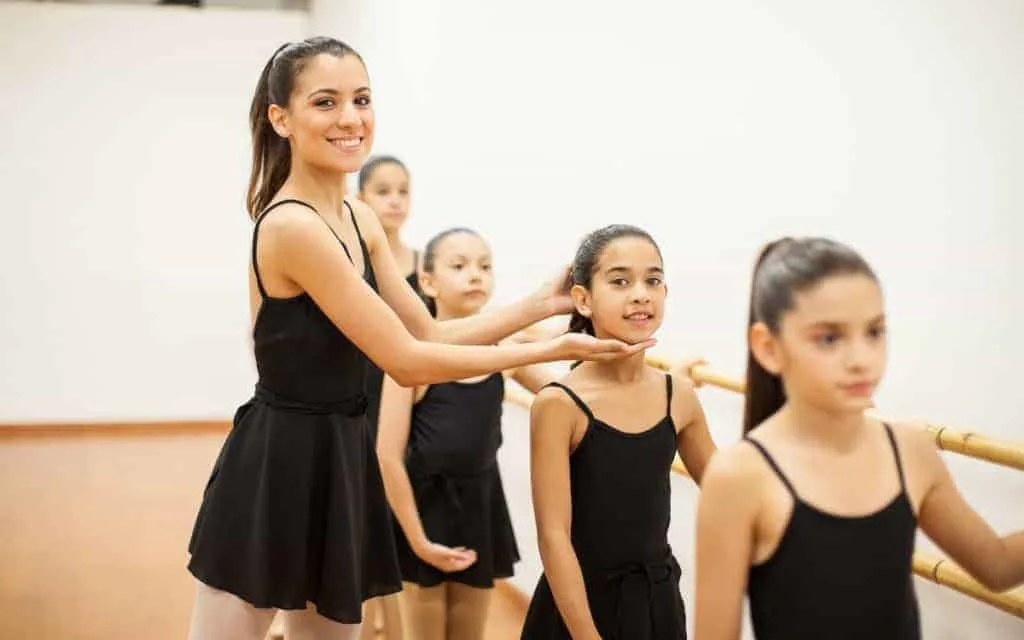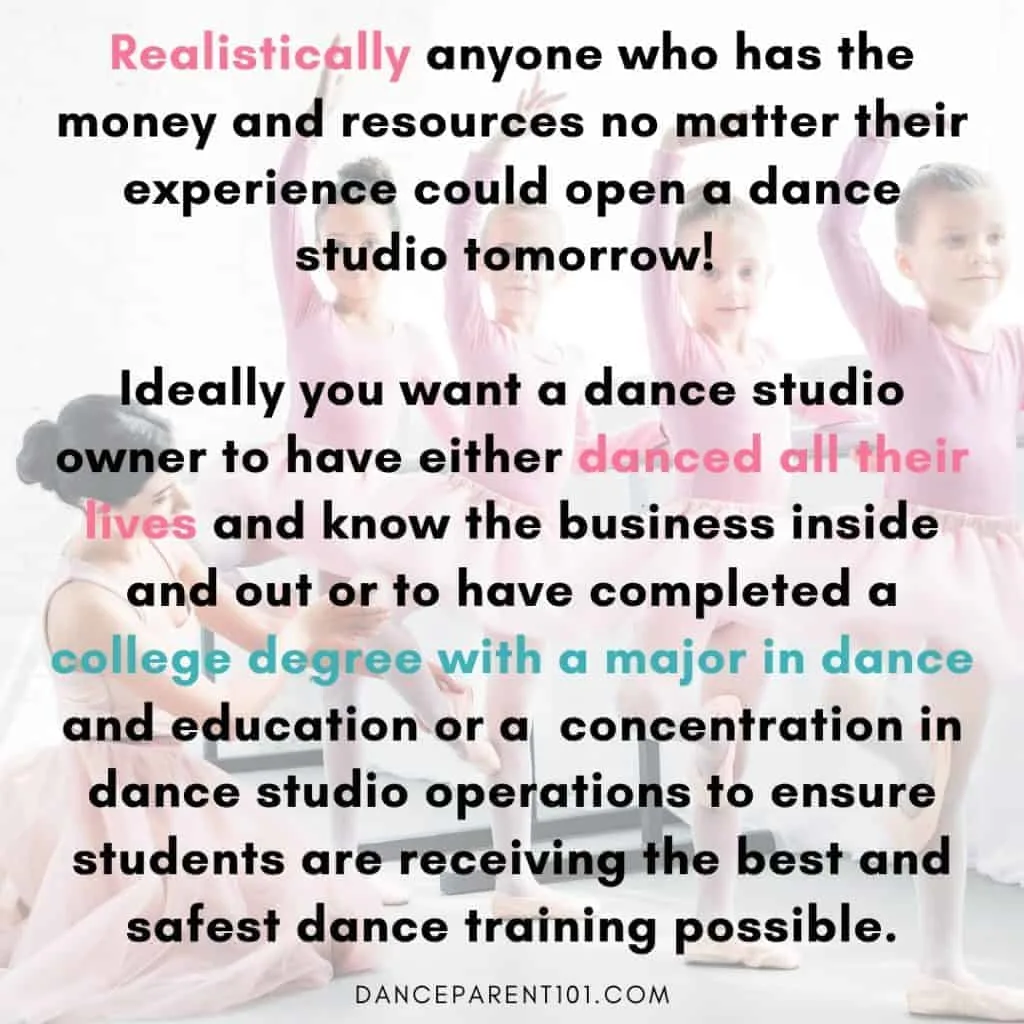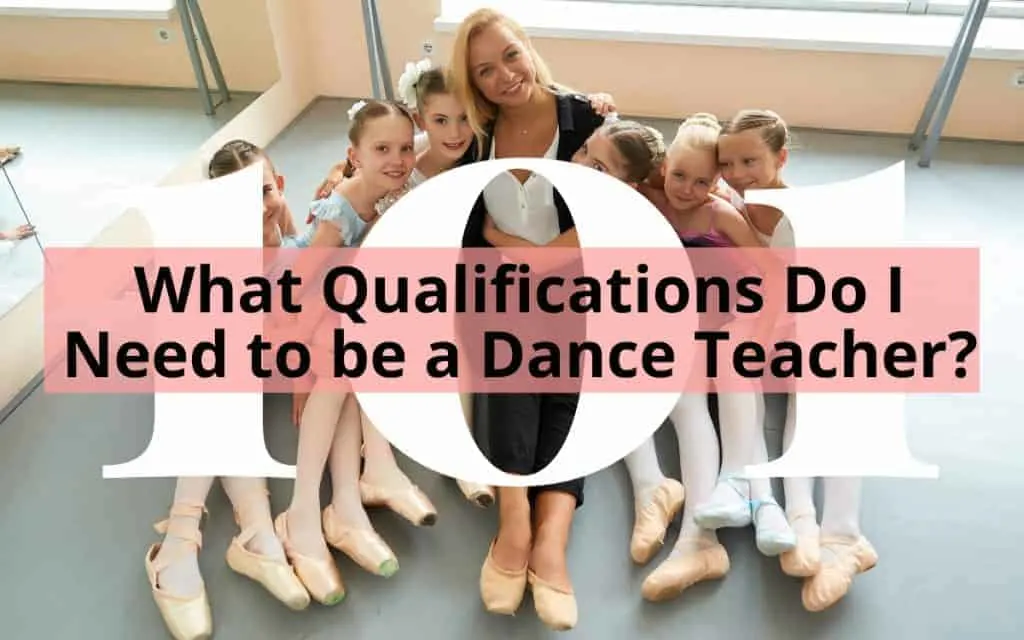
To become a teacher in a school the path is pretty simple and clear cut. You need to finish high school, go to university or college and get a teaching degree so your state or governing body can certify or license you to teach in the school system. But do you have to do this to teach dance? Do you need a degree or a qualification to teach dance?
To become a dance teacher and work in or open your own studio you do not need a qualification in dance, you need experience. To teach dance in public schools and other state-run organizations you generally need a qualification such as a bachelor’s degree with a major or minor in dance and education studies to enable you to be licensed or certified by your state.
So in some cases yes you need a qualification to teach dance, but in many others, you don’t, which kind of makes it sound like any Joe Blow could wake up one day and say – gee today I am going to teach dance! And in reality, anyone could…… But it’s not as clear cut and easy as that as I will explain throughout the article as we look at the different pathways you could take to become a dance teacher without a qualification and how much a teacher would make per class without a qualification, but to begin with, some bonus information about the responsibilities of being a dance teacher!
5 Key Responsibilities of a Dance Teacher?
- A dance teacher is responsible for the learning and dance education of their students as well as their student’s well-being and safety whilst under their instruction. A good dance teacher will educate their students on current and up to date best dance practices that teach correct technique, alignment and warm-up and cool-down exercises that help to prevent injury in their students both during class and when practicing skills at home.
- A skilled dance teacher knows how to efficiently run a dance class. They are proficient in teaching a structured class with a warm-up and cool down, exercises that teach technique and alignment, and are able to create choreography or dance routines to complement the learning of these skills.
- An effective dance teacher knows how to gradually increase skill level dependent on the experience of their students.
- A perceptive dance teacher will be attuned to the emotional and mental health needs of their students and know when to push them to achieve in their dancing and when to allow the dancer to learn at their own pace and level.
- A competent dance teacher will understand and have business knowledge. At the teaching level they should know how to invoice to be paid, process receipts, understand local occupational health and safety laws and understand copyright laws for choreography and music. At a studio owner level, they need to have a sound understanding of running a business.

Two pathways to teaching dance without a qualification?
Yes, you can teach dance without a qualification and below I outline two different pathways that this could happen, but with the above responsibilities in mind, although you do not need a qualification to teach dance in all circumstances (although having some sort of qualification really is advisable), you do need experience as a dance student, experience teaching or experience as a professional dancer.
PATHWAY 1: Professional Experience
To become a teacher through this pathway it means that you will have studied dance to the point that employers are actually willing to pay you for your talent. To read more about the time it takes to become a professional dancer you can read our article on the topic how many years does it take to be a professional.
At this point in their career, many professional dancers turn to teaching dance during periods that they are not professionally employed or teach once their professional dance careers have ended. They are employed by privately run studios on the basis of their ability to inspire and transfer their experience and knowledge of dance and the industry to their students.
In many cases, they have no formal teaching qualifications and you may even find that they do teach as a guest in universities, public schools or other institutions but always under the supervision of a licensed teacher who is still responsible for the students learning.
It is also common for professional dancers to open up their own dance studios and many parents of dancers and students are happy to pay these professionals to impart their understandings and knowledge of how they made a career in dance, even without any formal qualifications.
PATHWAY 2: On the Job Training
There is a saying those who can’t do, teach and there are many teachers out there today who are passionate dancers but for some reason never forged a professional career in dance. Many dancers today may have been approached by their teacher or another person at the dance studio or applied to be a teacher’s assistant or to teach beginner classes and through these experiences gradually gained on the job training and became a dance teacher, teaching at their dance school or other local studios.
Having no qualifications and on the job training is generally fine when teaching at other people’s studios as the owner is ultimately responsible for the education and well-being of their students, but I would offer a word of caution to those wanting to open their own dance studio with no form of qualification at all.

When Do You Need To Go To University To Get A Degree To Be A Dance Teacher?
There will be times that a university degree is required to be able to teach dance and other circumstances when one is not. The table below outlines the reasons why you might need a degree and situations when you would not.
NO
You do not need to go to university or college to be a dance teacher as long as your goal is to teach dance in privately owned studios, online or in some community settings. That being said, many people today who own their own studios have completed some sort of college dance program whether it be an associate or bachelors degree, or even a certificate especially for dance studio owners to give them not only an edge over other dance teachers and schools in their local areas but also because they are passionate about dance and want to be the best dance teacher they can be for their students.
YES
If you want to teach dance at a K-12 school, especially public schools, you will need to get a degree to teach dance. You can check out out article Dance Colleges Across All 50 States: The Ultimate List with Links to find a college or university near you with a dance program.
Every state and country is different and has varying requirements and laws that you need to comply with to receive your teaching certification therefore before choosing your college or university you need to contact the education board in the state you wish to teach in and confirm for yourself that they will grant you a teaching license from doing that course of study especially if you intend to go to college in a different state.
When do you need certification to teach dance?
A certificate or diploma are different to a university degree, the main difference being the length of time it takes to obtain one. A university degree takes generally four years and a certificate can take as little as a day, 3 months, a year or longer.
NO
You do not need any certification to teach dance within a privately run studio, but having one would make you more employable.
However, you may need some sort of license or police check to work with children or an occupational health and safety certificate or even a gym or fitness instructor certificate to meet the insurance and quality control requirements of an employer.
YES
You will need to be certified by your state or governing body to teach dance in a K-12 school setting. A university or college degree will not certify you to teach in a school, it is a requirement to be able to get your certification or license to teach.
Another reason for needing a certificate is if you were wanting to teach a particular curriculum, program or syllabus of dance. For example, the Royal Academy of Ballet is an organization originally developed by ballet teachers in the UK who felt the standard of teaching in their country was not up to scratch. These choreographers and dance teachers believed if they created a syllabus and an examination process that they could elevate the standard of ballet teaching and therefore the standard of the dancers being produced in the UK at the time. What they created was a roadmap one of the current leading ways of learning and teaching ballet that is used throughout the world. To teach the RAD syllabus as it is called you generally need to have studied the syllabus as a student for many years and to have passed student examinations before eventually passing a teaching examination to certify you to teach their curriculum.
There are many different syllabuses and curriculums all over the world and all of them require a prospective teacher to have experience as a student going through their program and passing any tests or examinations required to move up their levels, then to have experience as a student-teacher or teacher in training to eventually pass an examination and gain a teaching certification to be able to teach their curriculum.
How much does a dance teacher without qualifications make per class?
To be honest there is no research out there to tell you exactly how much a teacher without qualifications would make per class compared to a teacher with qualifications. But common sense tell us that at the end of the day if you are teaching for someone else, or even if you have your own studio your students will only be willing to pay you as much as they believe your teaching skills, experience and in some cases reputation are worth and how much your teaching can enhance their dancing.
For up to date information on how much dancers including teachers are paid please check out our article How Much Do Dancers & Ballerinas Make? Salary & Earnings Guide as this article is updated annually.
A final word of advice (from a mom, school & dance teacher)
Although having no qualifications and only professional experience or on the job training are a valid ways to become a dance teacher and there are many dance teachers out there on these pathways, in today’s world with occupational health and safety laws, people being sued for even minor errors and the fact that you are taking on the responsibility of the education of others, you should do yourself and your students a favor and get some formal qualifications and education. Whether it be a certificate or degree in dance and education, or running a dance studio or even a course at your local community college in business, fitness or child psychology, a qualification although not always required will help you become a better informed, confident and employable dance teacher. For a list of colleges across the US that offer degrees and courses in dance check out our article Dance Colleges Across All 50 States: The Ultimate List with Links
Related Articles You Might Like To Read
PLEASE NOTE: This article is for information purposes only, a spring board or starting point that will give you ideas, resources and links to help you on your journey to become a dance teacher. The information contained in this article is very broad and is meant to help everyone no matter which country or state you live in but may not be accurate for your circumstances therefore you will need to research your countries or states laws on teaching especially teaching children.



